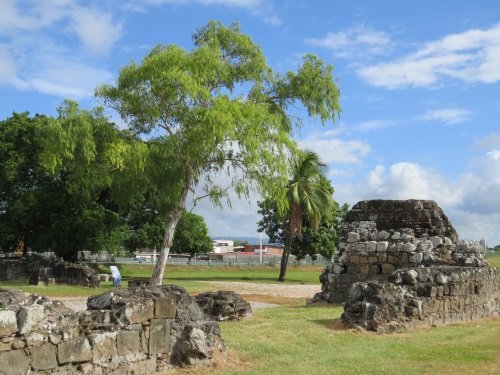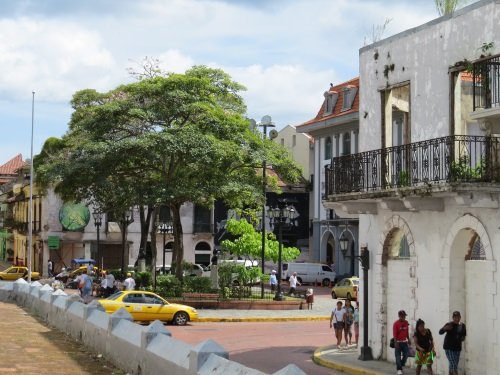This
Panamá City WHS
covers two locations along the Pacific Coast: the site of the oldest European town on the American mainland and the first European settlement on the Pacific Coast of the Americas. It was inscribed in two stages, with reasons for inscription varying from inter-oceanic communications to Panamanian house-types, and from 16th/17th century town planning and architecture to Simon Bolivar's visionary attempt in 1826 to establish a multinational congress in the Americas. Whenever I see so many different arguments put forward, I always suspect real Outstanding Universal Value is lacking: such value surely would be much easier to pinpoint.
On my way to Nicaragua I included a 3 day stop-over in Panamá, and used it to explore this hard-to-grasp WHS and its Atlantic Ocean counterpart
Portobelo
.

|
|
Panama Viejo
|
Panama Viejo lies in a relatively quiet area north of the city center. The Metrobus dropped me at the entrance, where I was asked to pay the foreigners fee of 8 US dollar. This ticket includes both the museum and the archaeological site. The museum does only cover one floor, but presents the story of this site well. This was the first spot where the Spaniards settled on the Pacific Coast. It was clear from the start that the location wasn't great: a lack of drinking water and healthy environment sent them looking for an alternative from 1531 on.
The remains of this old settlement are spread out on a narrow stretch of land along the Pacific coast. I enjoyed walking here, I was mostly on my own until I got to the central square where the cathedral is. The best preserved buildings are the remains of churches of various religious orders. I had to laugh about a sign at the Casa Alarcon: this was built by the clergy in 1590 (thanks to alms) as a house for rent and generate income. However, the clergy including the Bishops started using it themselves without paying anything.

|
|
Plaza de la Independencia, Casco Viejo
|
The other half of this WHS lies not far away, some of the metrobuses between Albrook Station and Panama Viejo even stop near Casco Viejo too. This historic district seems to be visited once every few years by visitors of this website, and the main question always is: how is the state of conservation at the moment? Getting there definitely has gotten safer over the years, and there now is a metro station from where you can walk into Casco Viejo. Also, according to an inventory dated April 2013, some 75% of the buildings are presently in a good state of conservation. This figure was only 5% at inscription in 1997. So they definitely have come a long way.
The area now is tourist central: the historic buildings are home to lots of restaurants, cafés, boutiques, souvenir shops. Unfortunately there's quite a lot of traffic in the streets, mainly taxi's and minibuses dropping off tourists. I visited on a Sunday, and although the atmosphere certainly was lively most of the churches and museums were closed. So I just walked around a bit. I searched for the "Salon Bolivar", the enigmatic location that was highlighted in the site's first nomination as a WHS. Probably it was closed too. In all, I did not find Casco Viejo that special.

|
|
The infamous maritime viaduct
|
A huge controversy has been going on about this WHS during the past WHC meetings. A maritime viaduct has been constructed around Casco Viejo, blocking its access to the sea. This could lead to delisting of the site in 2015, although it was never placed "in danger".
This study by Lynn Meskell
attributes this leniency to the dominance of the
BRICS
countries in the WHC during the last decennium. They like to see economic progress, and support Panama for its efforts.
The maritime viaduct is finished now. There are 3 options left to prevent a crisis: the first is to limit the WHS to only Panama Viejo, the second option is to limit the size and focus of Casco Viejo, and the third is to fundamentally change it to a serial nomination including the Camino Real and Panama Canal (capitalizing on the "inter-oceanic communications").
As the deadline of Feb 1 2015 is near, I have been searching the web in Spanish to see where Panama is heading. Option 2 is the
favourite
, as it seems to be the most likely (and easiest!) route. A deletion of Casco Viejo as a whole is seen as it could have negative effects for the conservation of that area. Whatever the outcome, Panama Viejo at least is without controversy and deserves its spot on the List for its role in the European settlement of the Pacific Coast of the Americas.



